IMO, one of the most awesome things about megagames is that people really struggle to define them.
Okay, I bet you’re confused. Why would that be awesome? Well, it means people will interpret it in a thousand different ways. Additionally, since megagames are live events, many people around the world are putting them on without ever having attended one before.
In many ways this is frustrating, and leads to people continually reinventing the wheel. It means that people will independently develop the same or similar mechanics. It means that people will stumble into common pitfalls they could have avoided.
But it means that no two megagames are alike. People are free to put their own spin on things, without worrying that they’re screwing everything up. Without the confines of THIS IS A MEGAGAME IF YOU DON’T HAVE ALL OF THIS YOU CAN’T CALL IT ONE, the variety of games available is growing and growing. People from different gaming backgrounds can add in or emphasise the elements of their favourite type of gaming. Megagaming is still very much an emerging game genre.
Take my own game, Everybody Dies, for example. My own gaming background is largely roleplay and board games. And my first megagame was Renaissance and Reformation, which I took a lot of influence from. There’s a massive focus on characters, on drama and decisive moments. Arguably the weakest part of the game, the combat, is because I don’t come from a wargaming background, unlike a lot of UK megagame designers.
And so I was super excited to chat to Ed, designer of Game of Alchemy, the newest Megagame idea to come out of Southampton. He comes from a strong LARP background, and so our conversation let me examine how a LARP-inspired megagame looks.
What is Game of Alchemy?
Game of Alchemy, or Alchemy, is set in Renaissance Europe. The majority of players will be alchemists, setting out to tackle the delicate and noble art of (you guessed it) alchemy.
Just in case you’re blanking, alchemy was the pseudo-science forerunner of modern chemistry. Practitioners tried to transform lead into gold, as well as create other mystical items such as the elixir of life and philosopher’s stone.
Throughout the game, players will be experimenting with various objects, trying to alchemise them into other materials. Or, as they call it, the World’s Most Awesome Game of Trial and Error. Players can make deals and alliances in order to share knowledge or resources with other players. They can be part of guilds or universities, who will support their members.
And they are grouped into nations, who have their own national objectives. Why would the rulers care about living forever if next door is invading tomorrow?
They are putting a TON of effort into the production value of the event. They recently kickstarted their map design, and here’s the beautiful copy they sent me:
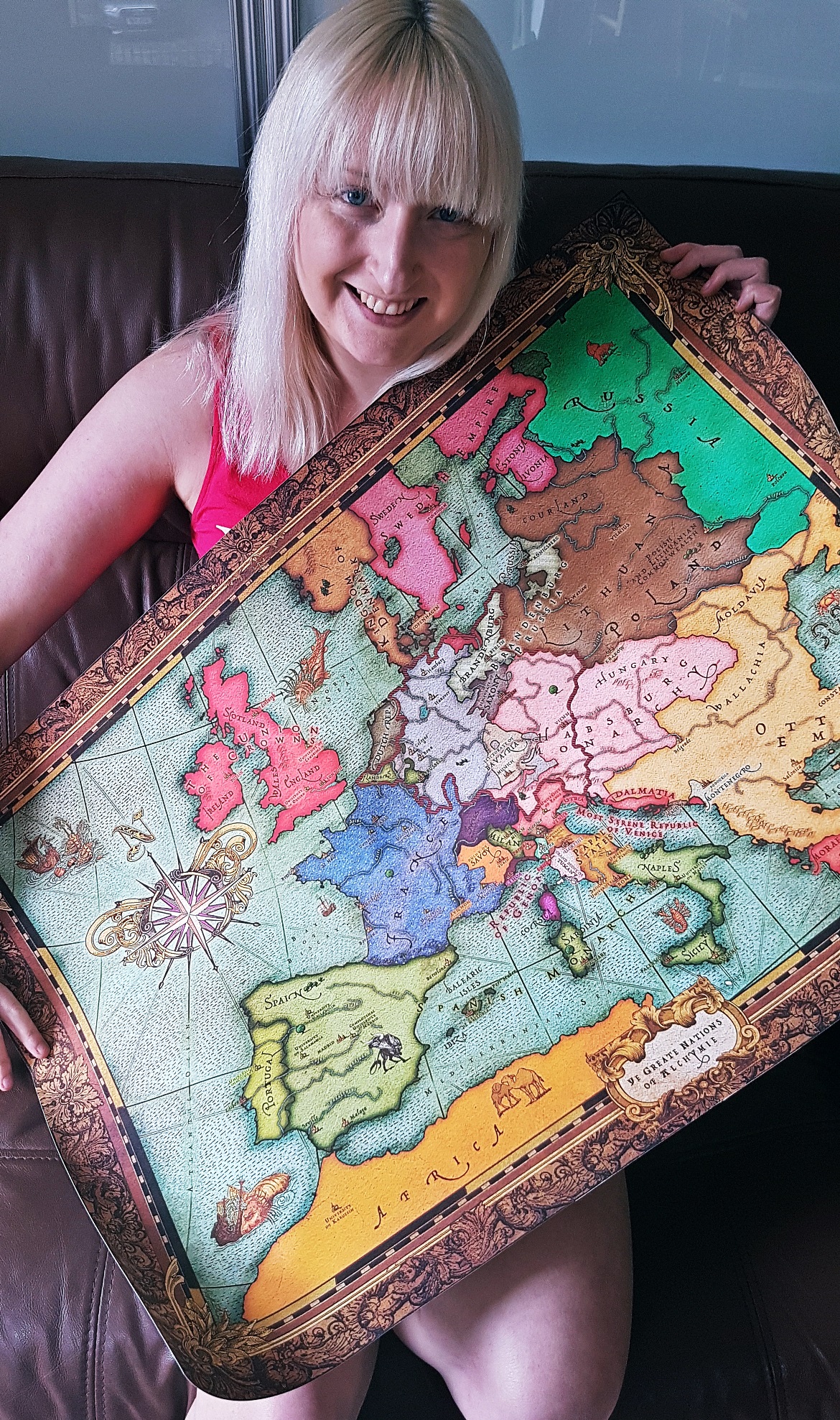
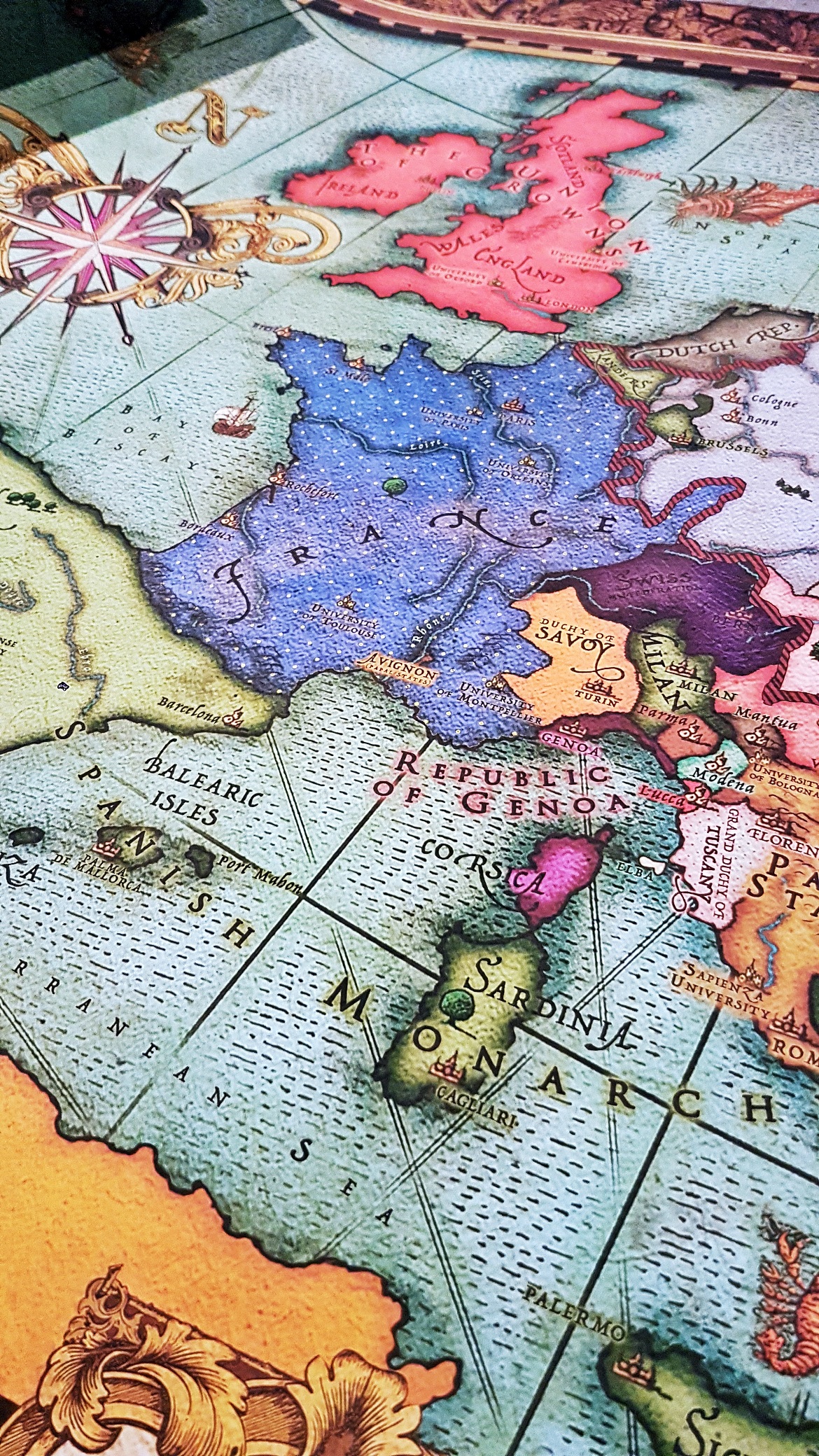
This blog post is going to focus a lot on the technical, mechanics side of the game, but if you’re interested in hearing more about the setting, watch their video:
What does an LARP-inspired Megagame look like?
There are a ton of differences between Game of Alchemy and your typical megagame, and it’s clear that Alchemy’s designers have been heavily influenced by their LARP background.
I often describe megagames as a cross between LARP and board games (or even a LABG, Live Action Board Game).
Meanwhile other people describe megagames and LARPs as convergent design. Megagames grew from a wargaming background, LARP from a roleplay background, and there’s some other type of game (usually subcategorised under megagaming) that developed from boardgaming.
But for me, I think there are some differences between megagames and LARPs, so I’ll be writing the rest of this post assuming they’re two different game types.
A note: megagames and LARPs encompass a massive spectrum of game types, and you’ll almost certainly be able to point me to examples of each that don’t fit the below. I fully admit that I’m making sweeping statements below, but I think overall they hold up well.
What Megagames and LARPs Have in Common
Game Size and Scale
Both LARPs and megagames involve a large number of people (compared to board games and tabletop roleplay). Megagames generally need a minimum of 25 players, while LARPs can be run with as few as 10 . The biggest one-site megagame had 300 players, while LARPs have gone into the 1000s.
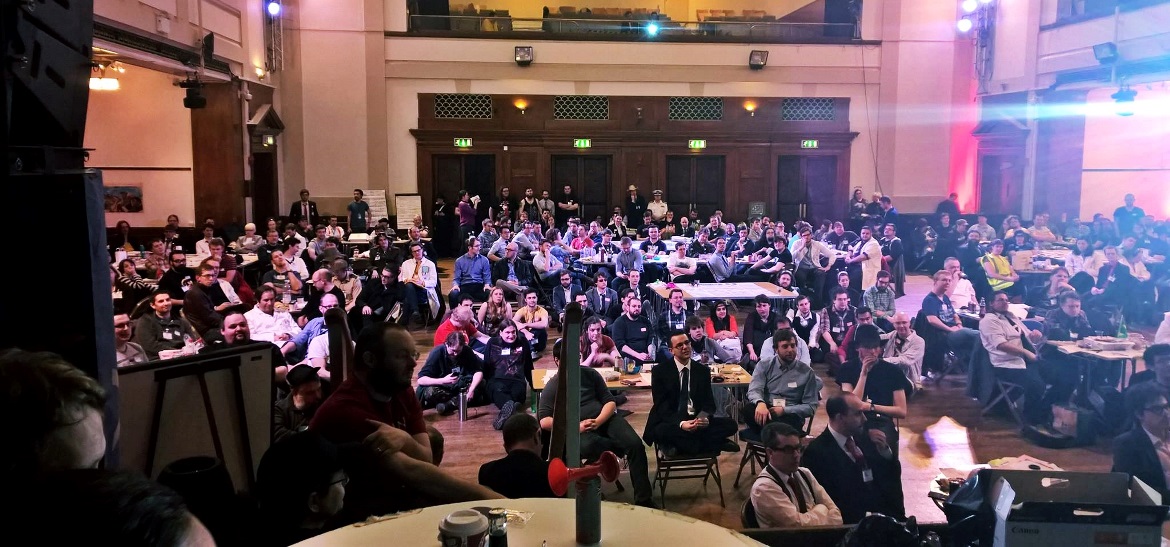
Image credit: Paul Howarth
Both game types last for an extended period of time. LARPs last from a few hours to a few days, while megagames generally last for 5-7 hours.
Both rely heavily on a team of game runners (GMs/crew/refs for LARP, Control for Megagames) to facilitate the game.
Abstractions
We’re all doing stuff we can’t really do in real life (well, most of the time). So both have mechanics to represent aspects of the game that can’t be physically replicated.
For LARPs, this is usually through “physreps”/props (items that pretend to be something else, such as a large square of paper being a trapdoor), “lammies”/”packets” (pieces of paper with information on) or “calls” (words and phrases that have a specific meaning, such as “HIT” meaning the player has dealt damage to another player).
In megagames, this is more usually through traditional board game elements such as cards and trackers.
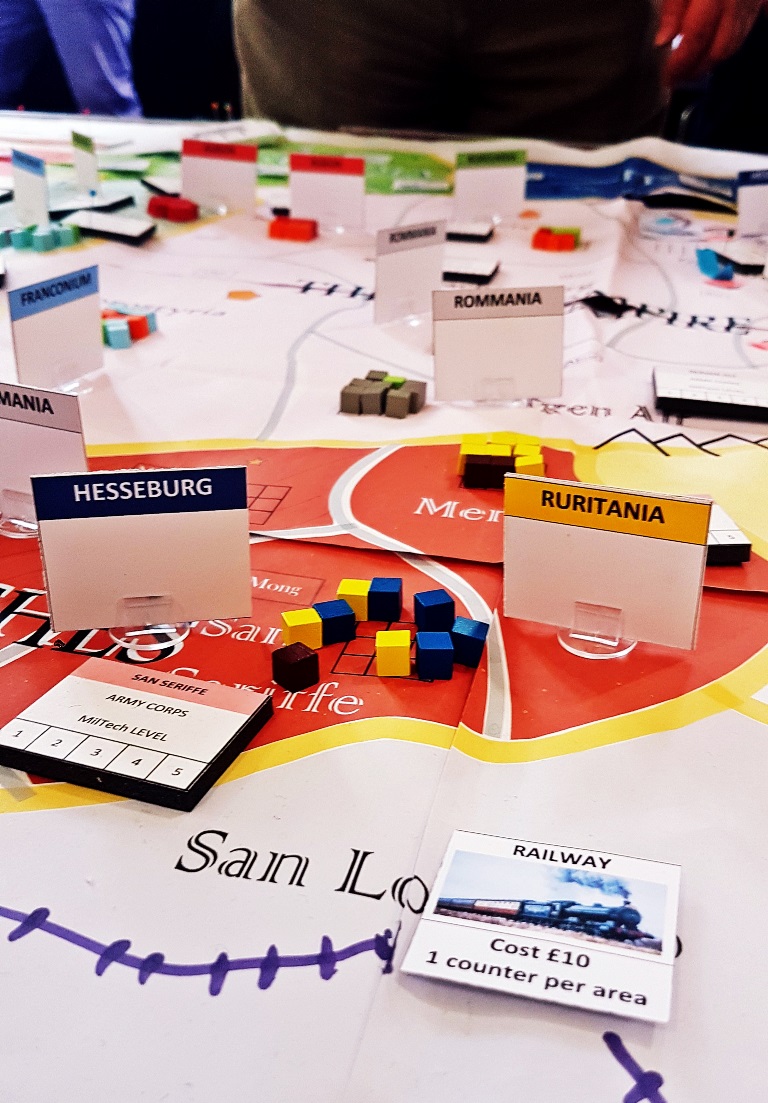
Mood
One of the biggest similarities is in terms of the game experience. Both game types rely heavily on building in-game relationships, and creating an in-game reputation for your character. Both require a huge amount of talking to other players, striking deals, and trusting people.
Megagames and LARPs are undeniably the most social forms of gaming out there. While other games allow you to talk over comms systems, or even brings small groups of friends to play together, megagames and LARPs exist solely because large groups of people want to come together to collectively build a narrative.
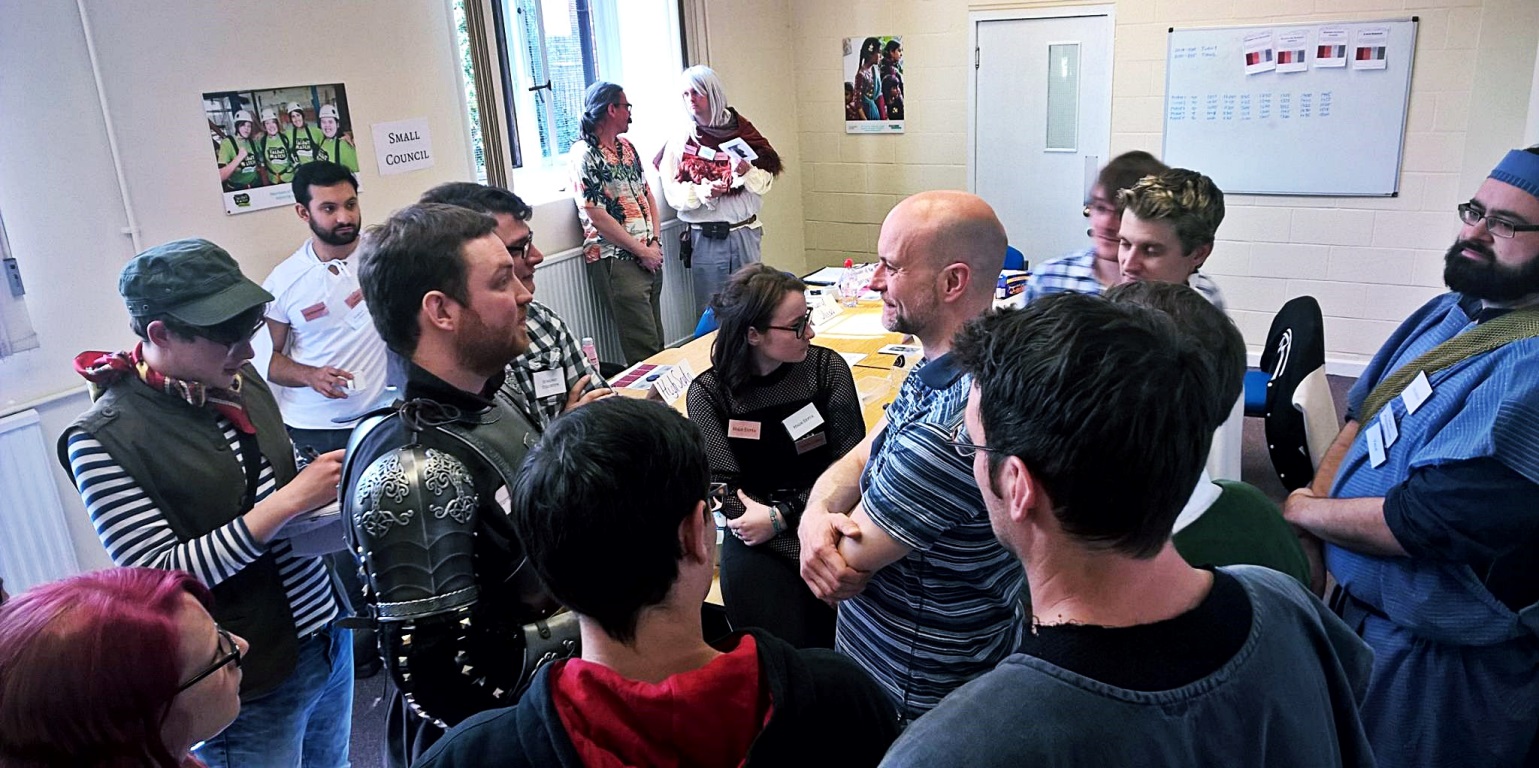
How Megagames and LARPs differ
Firstly I want to note that this section has changed significantly since I first wrote it. I’ve done a tiny bit of LARP during uni, and didn’t have a great experience tbh. When I ran what I originally wrote here by a couple more experienced LARPers, I realised I had some assumptions wrong.
Time Frame
A big difference is the turn structure. It’s easy to say that LARPs are real time, while megagames are usually turn-based with in-game time running faster than out-of-game time. And LARPs are sometimes set continuously, i.e. players can return to continue playing at the point they left off. This only rarely happens in megagames, and not usually with the same players.
But you could also consider that LARPs are turn-based, but each “turn” is a single session of a LARP. Either way, the timeframe of LARPs and megagames are pretty different.
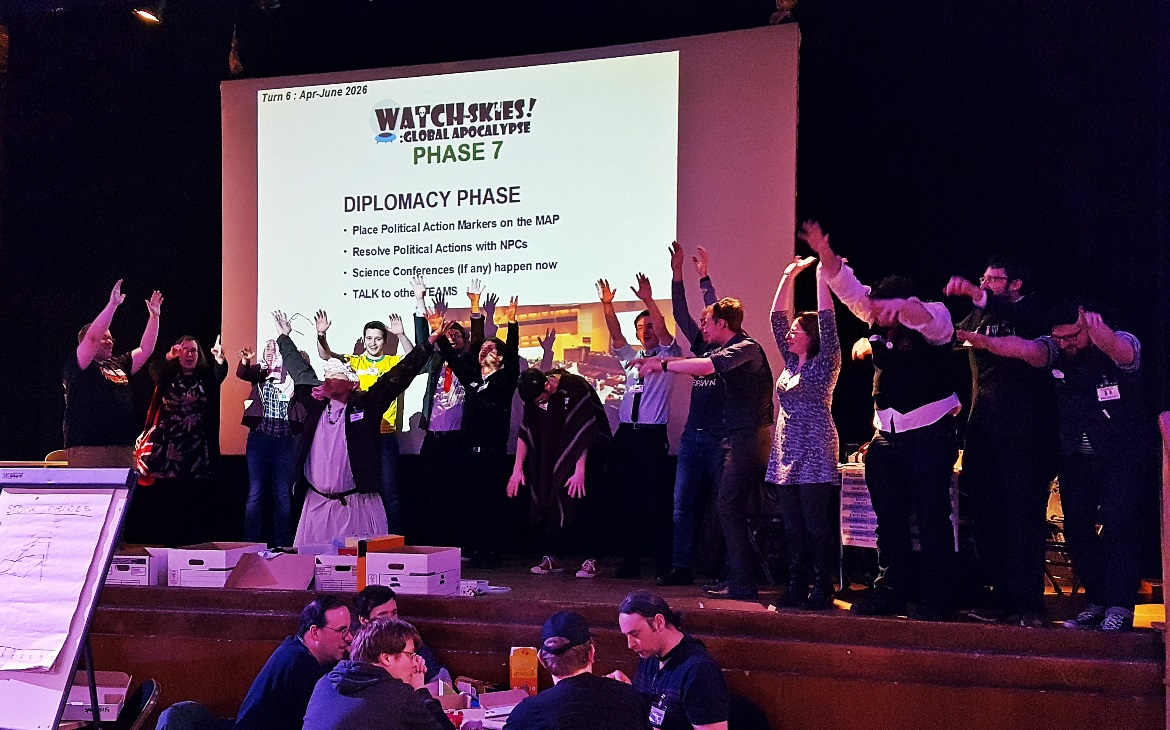
Resolution
Resolution time is another key difference. In megagames, the board game mechanics mean resolution is instant or very quick. In LARPs, any more complex resolution is left for “downtime”. This is the period of time between LARP sessions, where players submit actions it would be difficult or impossible to do within a normal session. This means resolution is a lot slower.
Characters
LARPers usually take on entire characters with personal backgrounds, motivations and characteristics that may be significantly different from those of their players. Players often write characters themselves. LARPers are encouraged to be “in character” all of or most of the time, and most LARPs heavily encourage or even require costumes.
Megagamers more often take on pre-written roles, whereby they have certain responsibilities to carry out, with no change to their own personality. Megagamers are encouraged to roleplay as much or as little as they like: some roles are often fully roleplay, while some are fully mechanical, and some are in between. Most megagames have no costume requirements or recommendations.
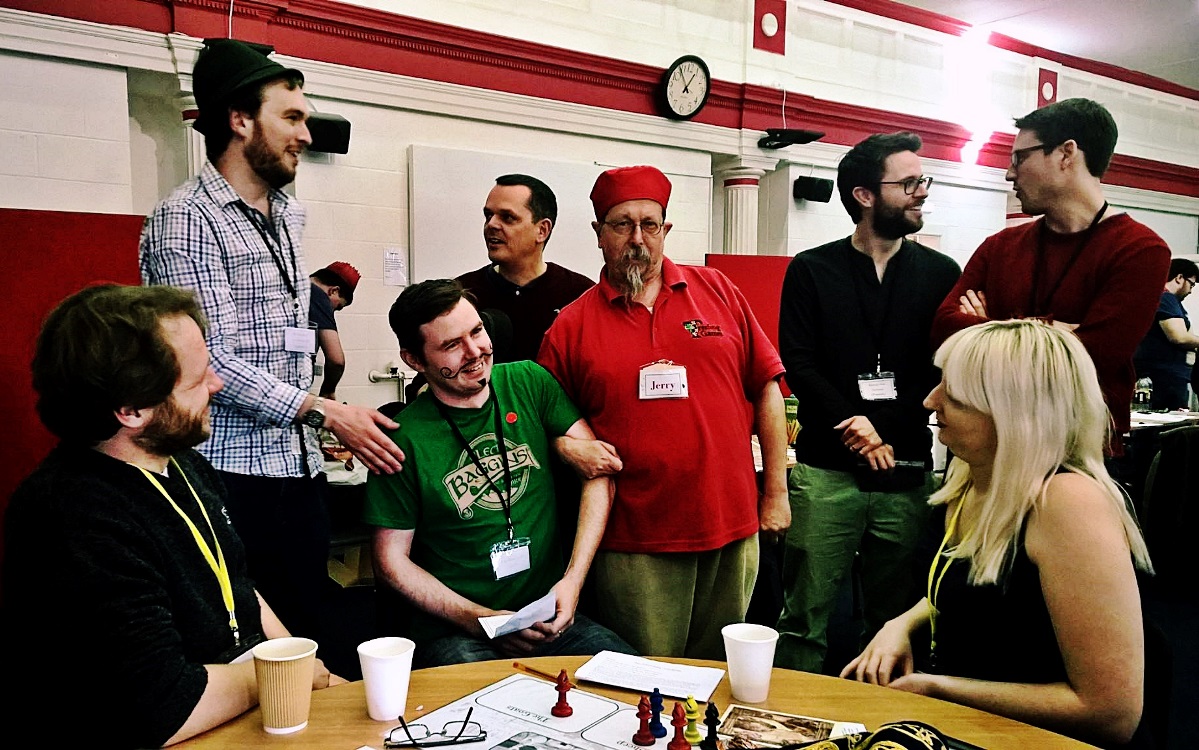
Additionally, LARPs normally have a very flat team structure, while megagames usually have a team hierarchy. In megagames, it is common for some roles to have access to mechanics that other players don’t, whereas in LARP generally all players interact with the same set of mechanics (excluding some very specific ones, such as magic).
Scope
Megagames often involve a very large scale situation, where players are representing the key figures in that situation – such as a war, with players as the kings, generals, diplomats. The game is designed to explore the setting and scenario, with the players selected to help resolve that scenario.
LARPs may have similar settings, but are far more likely to be zoomed in – insignificant in terms of any effect they could have on the overall situation, but highly focused on the lives of the individuals involved. Their game is much more about exploring the character development and individual challenges during a scenario.
It’s common to hear that megagames are “play to win” while LARPs are about the emerging narrative. Overall I disagree. There are some games, including many of the later runs of the famous Watch The Skies, for example, where achieving international recognition as a powerful nation is a key objective. But there’s no grand scoreboard. And that’s far from your only objective. You won’t walk away with a definitive winner and loser. Every player, post-megagame, will be happy to recount the various ways in which they “won”.
Megagame designers often brief in “weaknesses”. It’s sadly not uncommon for players to ignore these in favour of competitive advantage, but players who are willing to commit to playing up to their self-destructive objectives will have a far more interesting megagame. For example, at A New Age Dawns, TC was King of Spain and was encouraged to spend a game phase away “hunting”, not participating in the game actions at all. In a LARP, a player may decide to roleplay someone easily distracted, whereas in a megagame you’d never do that unless specifically briefed to do so. In fact, doing so when not briefed would likely irritate your fellow team mates and the control team.
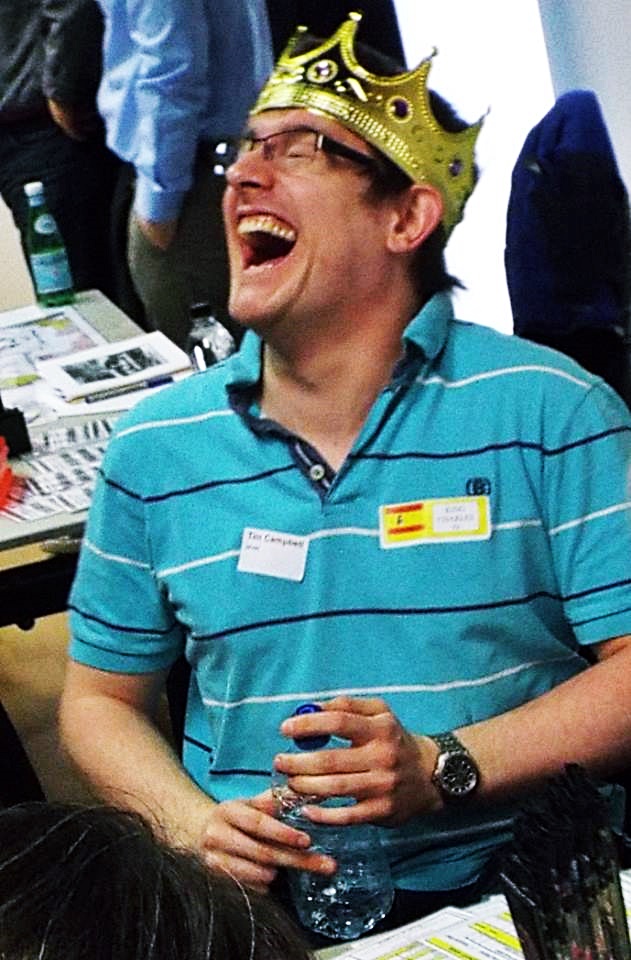
Image credit: Jim Wallman
Abstraction
Megagames are considerably more abstracted than LARPs. At a LARP, you are considered physically present, and an action done against your person is done against your character. At a megagame, you may never be in the same place in-game as many of the other people in the room. If someone wants to assassinate you in a LARP, they just need to find you and start shooting. In a megagame, they need to come up with the in-game logic for locating you.
Megagame objectives come from a very logical place – given that you are King of Evzonia, your aims are about betterment of yourself, your country, your rule and your people. This means that in-character objectives logically stem from your character, and so your in-character objectives are the same as out-of-character ones. This means that in-game conversations are fundamentally the same as out-of-game conversations.
This is where a lot of the “play to win” logic comes from. Players naturally want to do well in the scenarios they are put into. In reality, this makes megagames a lot more approachable than LARPs, because you don’t have to constantly be thinking “what would my character do”… because you ARE your character.
So is it a megagame?
Alchemy differs from what people traditionally think of as a Megagame in a ton of ways.
In terms of time frame, it follows a more LARPy pattern – it’s set continuously, with each game taking place chronologically immediately after the previous one.
However, resolution is faster than in a LARP. Players submit envelopes with their “experiments” in, and Control resolves them during the game. This is still slightly slower than is common at most megagames, but much faster than LARPs.
And unlike LARPs, where roleplay is essential in every part of it, Alchemy incorporates different play styles into the game. Some nations are heavily LARPy, with costumes and constant roleplaying being the big focus. Some have lighter roleplaying, and some are pretty much straight mechanical roles.
Alchemy also has a very flat team structure, with the majority of players being alchemists trying to achieve similar objectives. Personally I think megagamers may like the sound of their non-alchemist roles. Noble players govern each nation, dealing with issues like war, culture and religion. Meanwhile merchants travel around the room, buying and selling artefacts and materials, trying to make as much money as possible.
I think when I head along to Alchemy, I’ll be asking for a noble role. I love the politics roles in megagames, and spending most of the day dealing with the overarching plot, while other players get down and dirty with the nitty gritty of discovering the philosopher’s stone, sounds spot on for me!
Summary
Although LARPs and megagames have a lot in common, there are some fundamental differences. Personally, I’d land this game more on the LARP side than the megagame side.
But if you’ve never tried LARP before, or if you tried it and weren’t convinced, this could be a gentle step into the world of Live Action Role Play, with enough familiar elements of megagames to get you started.
You can find out more about Game of Alchemy on their YouTube channel. There isn’t a date set for their first game yet, but keep your eyes peeled!
Disclosure: I received a free copy of Game of Alchemy’s game map but that didn’t affect how pretty I found it. Here’s my full disclaimer.
